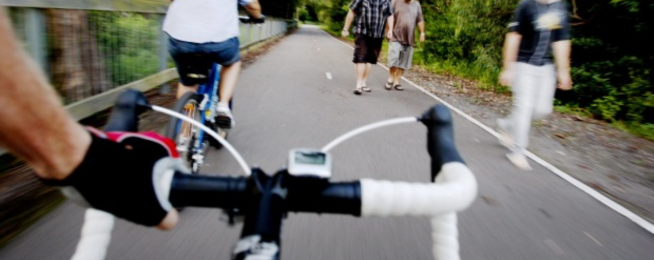A new and comprehensive study of pedestrian injuries resulting from collisions with people who ride bikes in Melbourne has found that such crashes are rare.
And when they do occur the injuries were generally not severe and thus did not result in long hospital stays.
Importantly, the collision rate and injury severity of pedestrian-bike rider crashes pales into insignificance when compared with the impact of collisions between cars and pedestrians.
The study should help put an end to the anti-bike chorus coming from pedestrian advocates who say people on bikes are a threat to people on foot.
As the study shows, in the 10 years between 2006 and 2016 there were 183 emergency department presentations and 273 admissions to hospital for pedestrian injuries as a result of being struck by a bike, compared with 4136 pedestrians presented to emergency departments and 6699 pedestrian hospital admissions as a result of a collision with a motor vehicle.
During this period the number of bikes, and pedestrians, on Melbourne streets increased rapidly, but the numbers of reported bike-pedestrian collisions has remained constant.
The study was undertaken by Steve O’Hern and Jennie Oxley of the Monash University Accident Research Centre, Australia and has been recently published in the journal Accident Analysis and Prevention.
The researchers say the "impetus for this study stemmed from anecdotal suggestions that cyclists were involved in increasing number of collisions resulting in pedestrian injuries, particularly when riding illegally on footpaths and also when riding on shared paths or in mixed use zones, where pedestrians and cyclists must interact within the same space.”
They analysed two Victorian data sources, the Victorian Injury Surveillance Unit (VISU) and Victorian Police Report Crash Data (Crash Stats).
They say the findings highlight that "efforts to increase active transport participation should be encouraged and there may be situations where is it suitable to increase interaction and sharing of space between pedestrians and cyclists.”
Where collisions did occur, they were more likely to be in denser, inner urban areas.
"In these areas there is a need for coordinated urban and transportation planning where appropriate facilities are provided for each mode of transport, they said.
"In many European countries with high cycling mode share, dedicated cycling facilities such as cycle tracks or bicycle lanes are provided to separate cyclists from pedestrian and motor vehicle traffic.
"These dedicated facilities should be considered in locations with high volumes of pedestrian and cyclist interaction, particularly in locations where cyclists travel at higher speeds.”
They also say: "The construction of a larger network of shared path facilities may also be another viable option to improve the pedestrian and cyclists infrastructure networks.
"Shared paths are fairly common throughout Australia and provide an off-road facility which is accessible by pedestrians and cyclists.
"They are typically cheaper to construct compared to separated pedestrian and cyclist facilities and are warranted in locations where there is demand for both pedestrians and cyclists.
"However the width of the path is a particular concern with these facilities, particularly from the perspective of pedestrians and the facilities should only be implemented in locations were the is sufficient width for cyclists and pedestrians to safely interact."
Become our friend
Find out more about Bicycle Network and support us in making it easier for people to ride bikes.


